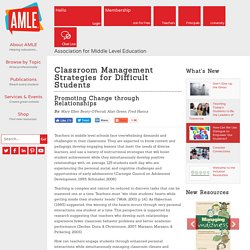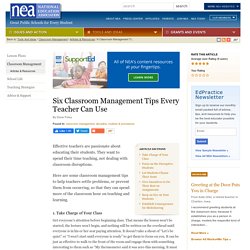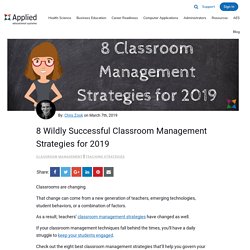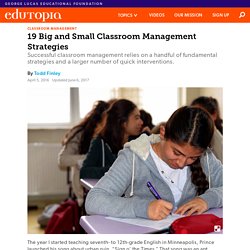

Classroom Management & Procedures - Tips for Math Classes. Setting Up the Classroom WorkflowWhen setting up your gradebook, instead of starting student names on the first line, leave a few rows blank so that you have space under the assignment heading for things like possible number of points, date, type of assignment, etc.

Learn names in those first few days by having a seating chart on your podium/desk always in view. Call on students in order going through the rows multiple times the first few days. Ask them to supply their homework answers and then use their names for any discipline reminders, etc. They will be very surprised that you know their name on the first day and will quickly realize they cannot get away with anything, especially if they are not aware that you have the seating chart in front of you. I’ve always been able to learn all the names (sometimes 150+) in just three days this way! Tips for GradingGrade homework using a four point rubric. Then, check out these posts to learn more about the specific strategies outlined above. 5 classroom management strategies for middle school. Middle school is a very challenging age group to teach.

You have some students who are maturing towards high school, and others who seem to still be stuck in third grade. This is also the age where students learn to begin testing authority and boundaries — this is (unfortunately) normal! In my experience, even with all of the raging hormones, boundary testing, and immature behavior, middle school students can also be a delight to teach. They come in ready to learn and are often simply looking for an adult who can guide them during this sensitive period of growth. Classroom Management Strategies for Difficult Students. Teachers in middle level schools face overwhelming demands and challenges in their classrooms.

They are expected to know content and pedagogy, develop engaging lessons that meet the needs of diverse learners, and use a variety of instructional strategies that will boost student achievement while they simultaneously develop positive relationships with, on average, 125 students each day who are experiencing the personal, social, and cognitive challenges and opportunities of early adolescence (Carnegie Council on Adolescent Development, 1995; Schmakel, 2008). Teaching is complex and cannot be reduced to discrete tasks that can be mastered one at a time. Teachers must "win their students' hearts while getting inside their students' heads" (Wolk, 2003, p. 14). As Haberman (1995) suggested, this winning of the hearts occurs through very personal interactions, one student at a time. Classroom management and relationship building Strategies for building relationships Building empathy Conclusion.
6 Classroom Management Tips Every Teacher Can Use. By Dave Foley Found In: classroom management, discipline, routines & procedures Effective teachers are passionate about educating their students.

They want to spend their time teaching, not dealing with classroom disruptions. Here are some classroom management tips to help teachers settle problems, or prevent them from occurring, so that they can spend more of the classroom hour on teaching and learning. 1. Get everyone’s attention before beginning class. 2. If students aren’t paying attention or busy doing other things, get them focused by using nonverbal signals of disapproval. If non-verbal cues are disregarded, the next step will be imposing discipline measures within the classroom such as having them stay a few minutes after class or changing their seat. 3.
At the beginning of the school year, let students sit where they want for a few days. 4. 8 Wildly Successful Classroom Management Strategies for 2019. Classrooms are changing.

That change can come from a new generation of teachers, emerging technologies, student behaviors, or a combination of factors. As a result, teachers’ classroom management strategies have changed as well. If your classroom management techniques fall behind the times, you'll have a daily struggle to keep your students engaged. Check out the eight best classroom management strategies that’ll help you govern your classroom and teach your students in 2019. Show enthusiasmCreate first-step compliancePrepareMaster transitionsFoster collaborationPractice follow-throughRemember to playStart a “tech off” policy Download the PDF >> Now that you know about each of these strategies, let’s take a closer look at each of them. 19 Big and Small Classroom Management Strategies. The year I started teaching seventh- to 12th-grade English in Minneapolis, Prince launched his song about urban ruin, “Sign o’ the Times.”

That song was an apt musical backdrop for the lives of my students, most of whom lived in poverty and challenged me daily. 5 Tips for Classroom Management in Middle and High School. Classroom management was my biggest struggle as a new teacher.

I went in suspecting I would have classroom management in the bag because I’d had pretty extensive experience working with kids from babysitting, being a camp counselor, and taking on similar volunteer-type roles. But as it turns out, managing a classroom was way different and way more difficult than anything I’d done before. In my first year, I had no procedures in place and thought that my students wouldn’t learn if I wasn’t always nice to them.
Because of this, I had zero control over my classroom. I was as helpless as a kitten. In my second year, I overcompensated for my leniency the previous year and behaved somewhat like a dragon. My third year is when things started to even out. Classroom management isn’t like following a recipe, where you follow exact steps and end up with a beautiful finished product. 1. A quiet voice is way more effective than a loud one in the long run. 2. 3. “I love doing Monday morning share!